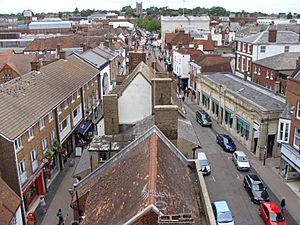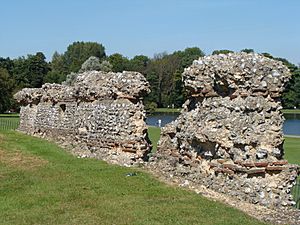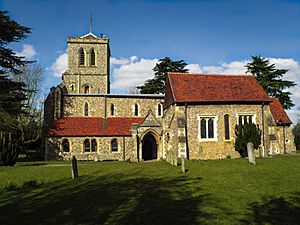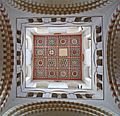St Albans facts for kids
Quick facts for kids St Albans |
|
|---|---|
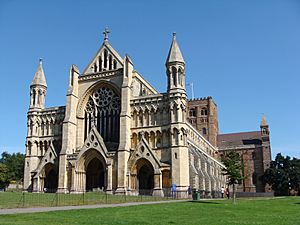 View of the west front of St Albans Cathedral |
|
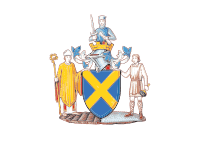 Coat of Arms |
|
| Area | 6.99 sq mi (18.1 km2) |
| Population | 82,146 |
| • Density | 11,752/sq mi (4,537/km2) |
| OS grid reference | TL148073 |
| • London | 19 mi (31 km) SSE |
| District | |
| Shire county | |
| Region | |
| Country | England |
| Sovereign state | United Kingdom |
| Post town | ST. ALBANS |
| Postcode district | AL1-AL4 |
| Dialling code | 01727 |
| Police | Hertfordshire |
| Fire | Hertfordshire |
| Ambulance | East of England |
| EU Parliament | East of England |
| UK Parliament |
|
St Albans is a cathedral city in Hertfordshire, England and the main urban area in the City and District of St Albans. It lies east of Hemel Hempstead and west of Hatfield, about 20 miles (32 km) north-north-west of central London, 8 miles (13 km) south-west of Welwyn Garden City and 11 miles (18 km) south-south-east of Luton. St Albans was the first major town on the old Roman road of Watling Street for travellers heading north and it became the Roman city of Verulamium. It is within the London commuter belt and the Greater London Built-up Area. With a population of 82,146, it is the fourth-most-populous settlement in Hertfordshire.
Contents
Name
St Albans takes its name from the first British saint, Alban. The most elaborate version of his story, Bede's Ecclesiastical History of the English People, relates that he lived in Verulamium, sometime during the 3rd or 4th century, when Christians were suffering persecution. Alban met a Christian priest fleeing from his persecutors and sheltered him in his house, where he became so impressed with the priest's piety that he converted to Christianity. When the authorities searched Alban's house, he put on the priest's cloak and presented himself in place of his guest. Consequently, he was sentenced to endure the punishments that were to be inflicted upon the priest, unless he renounced Christianity. Alban refused and was taken for execution. In later legends, his head rolled downhill after execution and a well sprang up where it stopped.
History
Celtic
There was an Iron Age settlement known as Verulamium, Verlamion, or Verlamio, near the site of the present city, the centre of Tasciovanus' power and a major centre of the Catuvellauni from about 20 BC until shortly after the Roman invasion of AD 43. The name "Verulamium" is Celtic, meaning "settlement over or by the marsh". The town was on Prae Hill, 2 km to the west of modern St Albans, now covered by the village of St. Michael's, Verulamium Park and the Gorhambury Estate. It is believed that the tribal capital was moved to the site by Tasciovanus (around 25 to 5 BC). Cunobelinus may have constructed Beech Bottom Dyke, a defensive earthwork near the settlement whose significance is uncertain.
Roman
The Roman city of Verulamium, the second-largest town in Roman Britain after Londinium, developed from the Celtic settlement and was granted the rank of municipium around AD 50, meaning that its citizens had what were known as "Latin Rights", a lesser citizenship status than a colonia possessed. It grew to a significant town, and as such received the attentions of Boudica of the Iceni in 61, when Verulamium was sacked and burnt on her orders: a black ash layer has been recorded by archaeologists, thus confirming the Roman written record. It grew steadily; by the early 3rd century, it covered an area of about 125 acres (0.51 km2), behind a deep ditch and wall. Verulamium contained a forum, basilica and a theatre, much of which were damaged during two fires, one in 155 and the other in around 250. One of the few extant Roman inscriptions in Britain is found on the remnants of the forum (see Verulamium Forum inscription). The town was rebuilt in stone rather than timber at least twice over the next 150 years. Occupation by the Romans ended between 400 and 450.
St Alban was probably buried outside the city walls in a Roman cemetery near the present Cathedral. His hillside grave became a place of pilgrimage. Recent investigation has uncovered a basilica there, indicating the oldest continuous site of Christian worship in Great Britain. In 429 Germanus of Auxerre visited the church and subsequently promoted the cult of St Alban.
There are a few remains of the Roman city visible, such as parts of the city walls, a hypocaust still in situ under a mosaic floor, and the theatre, which is on land belonging to the Earl of Verulam, as well as items in the museum. More remains under the nearby agricultural land which have never been excavated were for a while seriously threatened by deep ploughing.
Anglo-Saxon
After the Roman withdrawal the town, became the centre of the territory or regio of the Anglo-Saxon Waeclingas tribe.
St Albans Abbey and the associated Anglo-Saxon settlement were founded on the hill outside the Roman city where it was believed St Alban was buried. An archaeological excavation in 1978, directed by Martin Biddle, failed to find Roman remains on the site of the medieval chapter house. As late as the eighth century the Saxon inhabitants of St Albans nearby were aware of their ancient neighbour, which they knew alternatively as Verulamacæstir or, under what H. R. Loyn terms "their own hybrid", Vaeclingscæstir, "the fortress of the followers of Wæcla", possibly a pocket of British-speakers remaining separate in an increasingly Saxonised area.
Medieval
The medieval town grew on the hill to the east of Wæclingacaester where the Benedictine Abbey of St Albans was founded by Ulsinus in 793. There is some evidence that the original site was higher up the hill than the present building, which was begun in 1077. St Albans Abbey was the principal abbey medieval in England. The scribe Matthew Paris lived there and the first draft of Magna Carta was drawn up there. It became a parish church after the dissolution of the Benedictine abbey in 1539 and was made a cathedral in 1877.
St Albans School was founded in AD 948. Matthew Paris was educated there and it is the only school in the English-speaking world to have educated a Pope (Adrian IV). Now a public school, it has, since 1871, occupied a site to the west of the Abbey and includes the 14th-century Abbey Gateway. One of its buildings was a hat factory, a link with the city's industrial past.
On Abbey Mill Lane, the road between the Abbey and the school, are the palaces of the Bishops of St Albans and Hertford and Ye Olde Fighting Cocks, claimed to be the oldest pub in England.
Between 1403 and 1412 Thomas Wolvey was engaged to build a clock tower in the Market Place. It is the only extant medieval town belfry in England. The original bell, named for the Archangel Gabriel sounds F-natural and weighs one ton. Gabriel sounded at 4 am for the Angelus and at 8 or 9 pm for the curfew. The ground floor of the tower was a shop until the 20th century. The first- and second-floor rooms were designed as living chambers. The shop and the first floor were connected by a flight of spiral stairs. Another flight rises the whole height of the tower by 93 narrow steps and gave access to the living chamber, the clock and the bell without disturbing the tenant of the shop.
Two battles of the Wars of the Roses took place in or near the town. The First Battle of St Albans was fought on 22 May 1455 within the town, and the Second Battle of St Albans was fought on 17 February 1461, just to the north.
A street market on Wednesdays and Saturdays, founded by Abbot Ulsinus, still flourishes.
Modern
Before the 20th century St Albans was a rural market town, a Christian pilgrimage site, and the first coaching stop of the route to and from London, accounting for its numerous old inns. Victorian St Albans was small and had little industry. Its population grew more slowly than London, 8–9% per decade between 1801 and 1861, compared to the 31% per decade growth of London in the same period. The railway arrived relatively late, in 1858. In 1869 the extension of the city boundaries was opposed by the Earl of Verulam and many of the townsfolk, but there was rapid expansion and much building at the end of the century, and between 1891 and 1901 the population grew by 37%.
In 1877, in response to a public petition, Queen Victoria issued the second royal charter, which granted city status to the borough and Cathedral status to the former Abbey Church. The new diocese was established in the same year, in the main from parts of the large Diocese of Rochester.
In the inter-war years it became a centre for the electronics industry. In the post-World War II years it expanded rapidly as part of the post-War redistribution of population out of Greater London. It is now a popular tourist destination.
Geography
Climate
St Albans has an oceanic climate (Köppen climate classification Cfb) similar to most of the United Kingdom.
| Climate data for St. Albans Rothamsted No.2, elevation: 128m (1981–2010) | |||||||||||||
|---|---|---|---|---|---|---|---|---|---|---|---|---|---|
| Month | Jan | Feb | Mar | Apr | May | Jun | Jul | Aug | Sep | Oct | Nov | Dec | Year |
| Average high °C (°F) | 6.7 (44.1) |
7.0 (44.6) |
9.9 (49.8) |
12.7 (54.9) |
16.1 (61.0) |
19.2 (66.6) |
21.8 (71.2) |
21.6 (70.9) |
18.3 (64.9) |
14.1 (57.4) |
9.7 (49.5) |
6.9 (44.4) |
13.7 (56.7) |
| Daily mean °C (°F) | 4.0 (39.2) |
4.0 (39.2) |
6.3 (43.3) |
8.4 (47.1) |
11.5 (52.7) |
14.5 (58.1) |
16.9 (62.4) |
16.7 (62.1) |
14.1 (57.4) |
10.6 (51.1) |
6.8 (44.2) |
4.3 (39.7) |
9.9 (49.8) |
| Average low °C (°F) | 1.2 (34.2) |
1.0 (33.8) |
2.7 (36.9) |
4.0 (39.2) |
6.9 (44.4) |
9.8 (49.6) |
11.9 (53.4) |
11.8 (53.2) |
9.9 (49.8) |
7.1 (44.8) |
3.8 (38.8) |
1.6 (34.9) |
6.0 (42.8) |
| Average precipitation mm (inches) | 67.0 (2.64) |
47.7 (1.88) |
49.1 (1.93) |
54.1 (2.13) |
52.0 (2.05) |
52.7 (2.07) |
48.8 (1.92) |
62.5 (2.46) |
57.2 (2.25) |
81.1 (3.19) |
75.0 (2.95) |
65.1 (2.56) |
712.3 (28.04) |
| Average precipitation days | 12.1 | 9.4 | 10.2 | 10.2 | 8.8 | 8.6 | 8.0 | 8.8 | 8.9 | 11.0 | 11.6 | 11.0 | 118.5 |
| Mean monthly sunshine hours | 60.6 | 77.3 | 111.7 | 159.9 | 193.9 | 199.1 | 207.1 | 199.1 | 143.7 | 113.2 | 69.1 | 50.6 | 1,585.3 |
| Source: Met Office | |||||||||||||
Neighbourhoods
- Cottonmill
- Batchwood
- Bernards Heath
- Fleetville
- Highfield
- Hill End
- New Greens
- Sopwell
- Marshalswick (also extends into Sandridge parish)
- St Julians
- St Stephens (not to be confused with St Stephen)
- The Camp
- Townsend
- Jersey Farm
- Chiswell Green
Nearby towns and villages
 |
Redbourn | Harpenden | Welwyn Garden City |  |
| Hemel Hempstead | Hatfield | |||
| Watford | Radlett | Potters Bar |
- Other nearby towns: Borehamwood, Luton, Stevenage, Berkhamsted, Barnet (historically a separate town, a London borough since the 1960s)
- Nearby villages: Abbots Langley, Kings Langley, Bricket Wood, Colney Heath, Elstree, Frogmore, Lemsford, London Colney, Markyate, Park Street, Radlett, Redbourn, Sandridge, Wheathampstead, Shenley
- Nearby hamlets: Chiswell Green, Colney Street
Transport
Road
The north-south M1 motorway runs west of St Albans and the M25 motorway is slightly further south. The A414 road runs directly south of St Albans between Hemel Hempstead and Hatfield. The A405 road provides a direct link to Watford.
Rail
Two railway stations serve the city: St Albans City, which is situated 0.5 miles (800 m) east of the city centre, and St Albans Abbey, which is situated approximately 0.7 miles (1 km) south-west of the city station.
St Albans City on the Midland Main Line is served by Thameslink services, on a frequent and fast rail link to central London. Suburban services stop at all stations on the route, while express services are non-stop to London St Pancras. Trains run north to Harpenden, Luton, Luton Airport Parkway and on to Bedford. St Albans Abbey station is the terminus of the Abbey line from Watford Junction.
Culture and media
St Albans has a thriving cultural life, with regular concerts and theatre productions held at venues including Trestle Arts Base, St Albans Abbey, Maltings Arts Theatre, the Alban Arena, the Abbey Theatre, St Peter's Church and St Saviour's Church, given by numerous organisations including St Albans Bach Choir, St Albans Cathedral Choir, St Albans Abbey Girls' Choir, St Albans Symphony Orchestra, St Albans Chamber Choir, St Albans Chamber Opera, The Company of Ten, St Albans Choral Society, and St Albans Organ Theatre. St Albans is also home to Trestle Theatre Company, who have been creating professional, innovative and inspirational physical storytelling theatre since 1981. Originally known for their work with masks, Trestle collaborates with UK and international artists to unify movement, music and text into a compelling theatrical experience. The Sandpit Theatre is a theatre attached to Sandringham School which hosts a wide variety of plays throughout the year, mainly performances put on by the pupils of Sandringham School. The school also hosts Best Theatre Arts, a part-time theatre school for children aged 4 to 16.
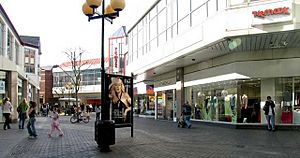
The St Albans Museum service runs two museums: Verulamium Museum, which tells the story of everyday life in Roman Britain using objects from the excavations of the important Roman Town; and the Museum of St Albans, which focuses on the history of the town and of Saint Alban. The Watercress nature reserve is by the River Ver and is run by the Watercress Wildlife Association.
St Albans Museums and Galleries Trust, in partnership with St Albans Museums and the University of Hertfordshire, have launched a project, "Renaissance: St Albans", to convert the old town hall into a museum and art gallery, combining the University's Margaret Harvey Gallery and the Museum of St Albans, which have closed in anticipation of the move. The cost of the project is £7.75m, of which (at February 2016) £6.3m has been raised.
The area is served by Radio Verulam, a community radio station.
The mixed character of St Albans and its proximity to London have made it a popular filming location. The Abbey and Fishpool Street areas were used for the pilot episode of the 1960s ecclesiastical TV comedy All Gas and Gaiters. The area of Romeland, directly north of the Abbey Gateway and the walls of the Abbey and school grounds, can be seen masquerading as part of an Oxford college in some episodes of Inspector Morse (and several local pubs also appear). Fishpool Street, running from Romeland to St Michael's village, stood in for Hastings in some episodes of Foyle's War. Life Begins was filmed largely in and around St Albans. The Lady Chapel in the Abbey itself was used as a location for at least one scene in Sean Connery's 1995 film First Knight, whilst the nave of the Abbey was used during a coronation scene as a substitute for Westminster Abbey in Johnny English starring Rowan Atkinson. The 19th-century gatehouse of the former prison near the mainline station appeared in the title sequence of the TV series Porridge, starring Ronnie Barker. The 2001 film Birthday Girl starring Ben Chaplin and Nicole Kidman was also partly filmed in St Albans.
More recently, several scenes from the film Incendiary, starring Michelle Williams, Ewan McGregor and Matthew Macfadyen, were filmed in St Albans, focusing in particular on the Abbey and the Abbey Gateway.
In popular culture
- The 1957 April Fools' Day spoof edition of BBC documentary series Panorama, which dealt with the fictitious Swiss spaghetti harvest, was filmed partly at the (now closed) Pasta Foods factory on London Road, St Albans.
- The 2001 film Birthday Girl, featuring Nicole Kidman and Ben Chaplin, is set in St Albans.
- A number of places across the world are named after the City of St Albans, most notably in Australia, New Zealand and the United States.
- St Albans was the name of a planet in the cult science-fiction television series Firefly.
- In September 2007, St Albans replaced Mayfair as the most expensive square on a special UK Here and Now Edition Monopoly board, having won an internet vote.
- Enter Shikari's song "All eyes on the Saint" (B-side of "Juggernauts" single) tells the story of St Alban.
- The BBC used the Main Gate House of the former St Albans Prison in Victoria Street as the main gate of "Slade Prison" in the sitcom Porridge.
Photo gallery
Sport
In December 2007, Sport England published a survey which revealed that residents of St Albans were the 10th most active in England in sports and other fitness activities. 30.8% of the population participate at least 3 times a week for 90 minutes.
Cricket
Clarence Park plays host to St Albans Cricket Club. The club currently runs four Saturday sides, playing in the Saracens Hertfordshire Cricket League and also two Sunday sides in the Chess Valley Cricket League. In 2008 the club's 1st XI won the Hertfordshire League Title. In the previous two seasons, the first XI came 5th (2011) and 4th (2012) in division one.
Football
The local football team is St Albans City FC: its stadium is on the edge of Clarence Park and the team won promotion from the Conference South League in 2005–06. It played in the Nationwide Conference Division of the Football Conference for the 2006–07 season, but finished at the bottom of the table and was relegated.
Gymnastics
St Albans Gymnastics Club, founded in 2005, provides the St Albans area with recreational classes as well as a professionally managed competitive squad.
Hockey
St Albans is also home to St Albans Hockey Club, based in Oaklands, St Albans. The club is represented at National league level by both women's and men's teams, as well as other local league competitions. The club's nickname is The Tangerines.
Rugby league
St Albans Centurions Rugby league Club have their ground at Toulmin Drive, St Albans. They play in the London Premier League. In 2007 and again in 2010 'The Cents', as they are known, won 'the triple' – topping the league, and becoming the Regional and National Champions of the Rugby League Conference Premier Divisions.
Rugby union
Old Albanian RFC is a rugby union club that plays at the Old Albanian sports complex. They play in National League 1 the third tier of the English rugby union system. Saracens A team and OA Saints Women's Rugby team also play here. This complex hosts the offices of the RFU Championship club Saracens (and have recently moved their home ground to Barnet). St Albans RFC play at Boggymead Spring in Smallford. Verulamians RFC (formerly Old Verulamians) play at Cotlandswick in London Colney.
Skateboarding
St Albans is home to one of the country's oldest indoor skateparks, the Pioneer Skatepark in Heathlands Drive, next to the former fire station. Its ramps are available to all skateboarders and inliners. A new outside mini ramp was built in March 2005. A second outdoor mini ramp was opened at Easter 2009.
Links with other sports
St Albans is additionally home to a community of traceurs from around Hertfordshire.
St Albans was once home to the then most prestigious steeplechase in England. The Great St Albans chase attracted the best horses and riders from across Britain and Ireland in the 1830s and was held in such high esteem that when it clashed with the 1837 Grand National the top horses and riders chose to bypass Aintree. Without warning the race was discontinued in 1839 and was quickly forgotten.
St Albans was once home to Samuel Ryder, the founder of the Ryder Cup. He ran a very successful packet seeds business in the 1890s which at one time he ran from a packing warehouse on Holywell Hill (currently Café Rouge). His interest in golf and sponsorship led to his donation of the now famous Ryder Cup. He is buried in Hatfield Road Cemetery, where in July 2012 the Olympic Torch Relay passed by to honour him.
Education
St Albans has many state primary and secondary schools, and a number of independent schools.
The law school of the University of Hertfordshire used to be based in Hatfield Road in St Albans until it moved to the university's De Havilland campus in Hatfield in 2011. Hertfordshire County Council purchased the site. The interior of the former law school building has since been refurbished and now forms part of Alban City School, a state-funded Free School for primary aged children, which started taking reception class children in September 2012.
A campus of Oaklands College, a further education college, is also located in Smallford in St Albans.
Notable people
Images for kids
-
St Albans High Street in 1807, showing the shutter telegraph on top of the city's Clock Tower
See also
 In Spanish: St. Albans (Hertfordshire) para niños
In Spanish: St. Albans (Hertfordshire) para niños




